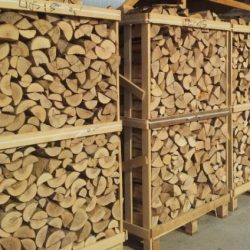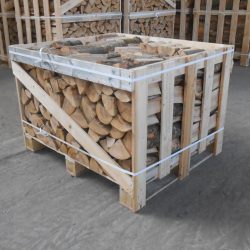Description
Beginner’s Guide to Quality Poplar Firewood: Find the Best

Quality Poplar Firewood is a term often associated with a unique type of firewood valued for its distinct characteristics. Poplar is a low-density hardwood that burns quickly, making it well-suited for short fires and kindling. Its fast-burning nature makes it a popular choice for fire pits and wood stoves during the milder spring and fall seasons, offering a cozy warmth without the heavy smoke or creosote. Whether you’re roasting marshmallows under the stars or enjoying a quiet evening indoors, poplar can add that sweet, nutty fragrance to your fire experience.
- Low-density hardwood: Easier to transport and handle.
- Fast-burning: Ideal for kindling and short-lived fires.
- Sweet scent: Adds a pleasant aroma to your fires.
Poplar’s ease of splitting and quick seasoning time, ranging from six to twelve months, make it a convenient option for many. Despite its lower heat output compared to denser hardwoods like oak or hickory, its moderate smoke production and low creosote make it a clean-burning choice. So, whether you’re an experienced firewood user or a beginner, understanding the qualities of poplar can help you make an informed decision for your next burning project.

Learn more about Quality Poplar Firewood:
Understanding Poplar Firewood
Poplar firewood is known for its unique properties that make it a popular choice for both indoor and outdoor fires. Let’s break down the key characteristics that define this type of firewood.
Low-Density
Poplar is a low-density hardwood, which means it’s lighter and easier to handle compared to denser firewoods like oak or hickory. This makes it an excellent choice for those who need to transport or stack their firewood frequently.
Fast-Drying
One of the standout features of poplar is its fast-drying nature. It can season in as little as six months, making it a convenient option if you need firewood on short notice. This quick seasoning time is a big advantage for those who want to stockpile wood without waiting years for it to dry.
Easy to Split
Poplar is also easy to split, which is a plus for anyone who processes their own firewood. Its straight grain and uniform texture make splitting much simpler, reducing the effort required to prepare it for burning.
Moderate Smoke
When burned, poplar produces moderate smoke. This characteristic is ideal for those who prefer a cleaner burn, as it helps minimize the amount of smoke and soot that can accumulate in chimneys or on outdoor furniture.
Sweet Scent
One of the charming aspects of poplar firewood is its sweet, nutty scent. This adds a pleasant aroma to your fires, enhancing the overall experience whether you’re enjoying a cozy evening by the fireplace or hosting a gathering around an outdoor fire pit.

By understanding these characteristics, you can better appreciate why Quality Poplar Firewood is a favored choice for many firewood enthusiasts. Whether you’re looking for an easy-to-handle option or want to enjoy the sweet scent it provides, poplar offers a range of benefits for your burning needs.
Quality Poplar Firewood: Characteristics and Uses
Poplar firewood is a versatile choice for various burning needs, thanks to its unique characteristics. Let’s explore its uses and benefits further.
Heat Output
Poplar firewood offers a heat output ranging between 12.2 and 18.2 million BTU per cord, depending on the tree variety. This is lower compared to denser hardwoods like oak or hickory. While it burns hot, it burns quickly, making it ideal for short, intense fires rather than long-lasting ones. This quick burn is perfect for warming up a space rapidly or for a cozy evening by the fire.
Seasoning Time
One of the most appealing aspects of poplar is its fast seasoning time. Poplar can be ready to burn in as little as six months, compared to the one to two years required for denser hardwoods. This makes it a convenient choice if you’re in need of firewood on short notice. Its fast-drying nature also means you can replenish your firewood supply swiftly, ensuring you never run out.
Indoor and Outdoor Use
Poplar’s moderate smoke production and low creosote levels make it suitable for both indoor and outdoor fires. Its sweet, nutty scent improves the ambiance, whether you’re gathered around an indoor wood stove or enjoying an outdoor fire pit. It’s particularly popular during the spring and fall months when a quick, warm fire is needed.
Fire Starter
Due to its fast-burning nature, poplar is an excellent choice for kindling and fire starters. Its ease of splitting and light weight make it simple to handle and prepare, providing a quick ignition source to get your fire going. This makes it a practical addition to any firewood collection, ensuring you can start a fire with ease whenever needed.
By appreciating these characteristics, you can see why Quality Poplar Firewood is a favored option for many. Whether you’re looking to enjoy a short, warm fire or need a reliable fire starter, poplar provides a range of benefits that cater to both indoor and outdoor fire enthusiasts.
Different Types of Poplar Trees
Poplar trees are a diverse group, with more than 30 species found worldwide. However, only a few are commonly used for firewood. Understanding the characteristics of these types can help you choose the best Quality Poplar Firewood for your needs.
Cottonwoods
Cottonwoods are among the most widespread poplar trees in the United States. They are known for their towering height, often reaching up to 100 feet. These trees have distinctive white or silvery lobed leaves with felted undersides and smooth, grayish bark. Cottonwood firewood burns with a clean, moderate smoke and is suitable for both indoor and outdoor fires. Its sweet, nutty scent adds a pleasant aroma to your fire experience.
Aspens
Aspens are another popular variety of poplar, recognized for their tall stature, often exceeding 115 feet. They feature dark gray bark and diamond-shaped green leaves. Aspens are valued for their clean burn and minimal smoke production, making them a good option for indoor use. Their fast-burning nature is ideal for quick fires, providing warmth rapidly without excessive smoke.
Balsam Poplars
Balsam poplars are notable for their grayish bark and green-toothed leaves. They can grow over 100 feet high, making them a substantial source of firewood. Balsam poplar firewood offers a moderate heat output and burns with low creosote, ensuring a cleaner burn. The aromatic buds of these trees add a distinctive, pleasant smell to your campfires, enhancing the overall experience.
Yellow Poplars
Despite their name, yellow poplars are not true poplars—they belong to the magnolia family. These trees can reach impressive heights of up to 195 feet, making them one of the tallest deciduous trees in the U.S. While yellow poplar firewood can be used for burning, it tends to burn quicker and produce more smoke compared to true poplars. This makes it less desirable for indoor fires but still useful for outdoor settings or as kindling.
By exploring these different types of poplar trees, you can better understand which variety suits your firewood needs. Whether you’re looking for quick-burning kindling or a pleasant-smelling campfire, there’s a poplar type that can meet your expectations.
Advantages and Disadvantages of Poplar Firewood
Poplar firewood is a unique choice for those who prioritize availability and ease of use. However, it comes with its own set of pros and cons that are important to consider.
Advantages
- Fast-Growing: Poplar trees are known for their rapid growth, making them a readily available resource. This quick growth ensures a steady supply of Quality Poplar Firewood.
- Low Creosote Build-Up: One of the standout benefits of poplar firewood is its low sap and resin content. This results in minimal creosote accumulation, reducing the risk of chimney fires. It’s a safer option for frequent indoor use.
- Easy to Split: Poplar wood is generally easy to split, making it a convenient choice for those who prefer to prepare their own firewood. Its straight grain helps in creating uniform logs, perfect for kindling.
Disadvantages
- Low Heat Output: While poplar is easy to light and burns quickly, it doesn’t produce much heat. This makes it less ideal for cold winter nights when you need a significant heat source. It’s better suited for mild weather or as a fire starter.
- Sparks: Poplar firewood tends to give off more sparks than other types of wood. This characteristic can be a safety concern, especially for indoor fires. It’s essential to use a screen or spark guard to prevent any accidents.
In summary, Quality Poplar Firewood is an excellent choice for kindling, quick fires, or when you don’t need intense heat. Its fast-growing nature and low creosote build-up make it a practical and safe option for many, but its low heat output and tendency to spark are factors to keep in mind.
Frequently Asked Questions about Poplar Firewood
Does poplar make good firewood?
Poplar firewood is often compared to softwoods due to its fast-burning nature. While it doesn’t produce as much heat as denser hardwoods, it has its perks. Poplar is excellent for kindling and quick fires. It lights easily and burns fast, making it ideal for starting a fire or when you want a short burn. However, if you’re looking for warmth, you might want to mix poplar with denser wood types that burn longer and hotter.
How long does poplar firewood need to season?
Poplar is known for its fast-drying properties. It generally requires a seasoning time of about six months under good drying conditions. For the best results, stack the wood off the ground in a crisscross pattern to allow air circulation. Cover it to protect from rain but leave the sides open for air flow. Properly seasoned poplar will burn more efficiently and produce less smoke.
What are the disadvantages of poplar wood?
Poplar wood has a few drawbacks that are important to consider:
- Low Heat Output: Unlike denser hardwoods, poplar doesn’t generate much heat. It’s suitable for mild weather but not the best choice for keeping warm on cold nights.
- Fast-Burning: Poplar burns quickly, which means you’ll need to add wood to the fire more frequently. This can be a hassle if you’re looking for a long-lasting fire.
- Sparks: One downside is that poplar tends to give off more sparks, which can be a safety concern. Always use a screen or spark guard, especially indoors, to prevent any accidents.
Despite these disadvantages, Quality Poplar Firewood is a good option for specific uses like kindling and quick fires. Its fast-drying nature and easy availability make it a convenient choice for many.
Conclusion
At Fruitdale Pellets LLC, we understand that selecting the right firewood is essential for a satisfying fire experience. With our globally available, high-quality wood products, we offer Quality Poplar Firewood that is perfect for several uses.
Poplar firewood is widely available and an excellent choice for those looking for a quick and easy fire. Its fast-burning nature makes it ideal for kindling and short fires, whether you’re lighting up an outdoor fire pit for a cozy evening or starting a fire in your indoor wood stove during the transitional seasons.
While poplar may not provide the prolonged heat of denser hardwoods, it is perfect for seasonal use during mild weather in spring and fall. Its low heat output and quick burn are complemented by a sweet, nutty scent, adding a pleasant aroma to your fireside gatherings.
For those looking to mix their firewood for better heat management, poplar pairs well with denser woods, providing a balanced burn. This combination allows you to enjoy the easy lighting of poplar while benefiting from the sustained warmth of other hardwoods.
Explore our selection of Quality Poplar Firewood and other wood products at Fruitdale Pellets LLC. Our commitment to quality and on-time delivery ensures you can enjoy the best firewood experience, no matter where you are.






Reviews
There are no reviews yet.